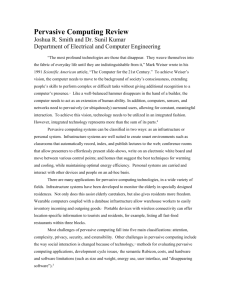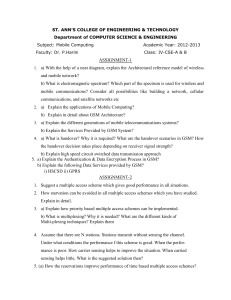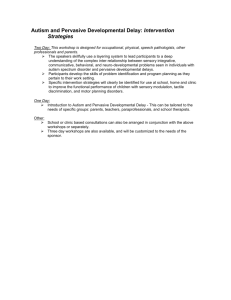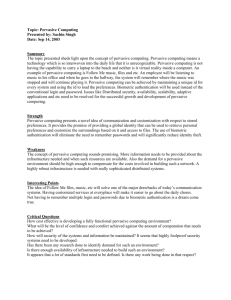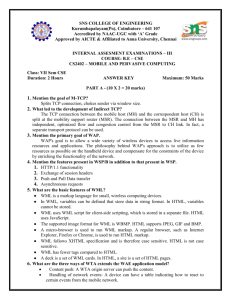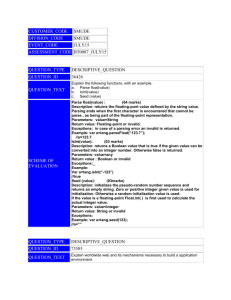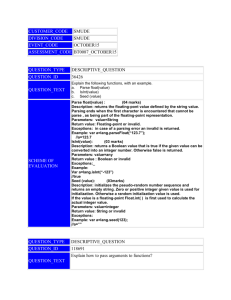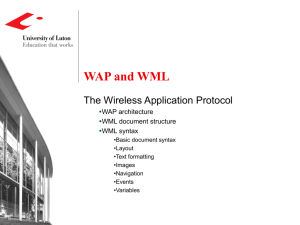two mark questions in unit-1
advertisement
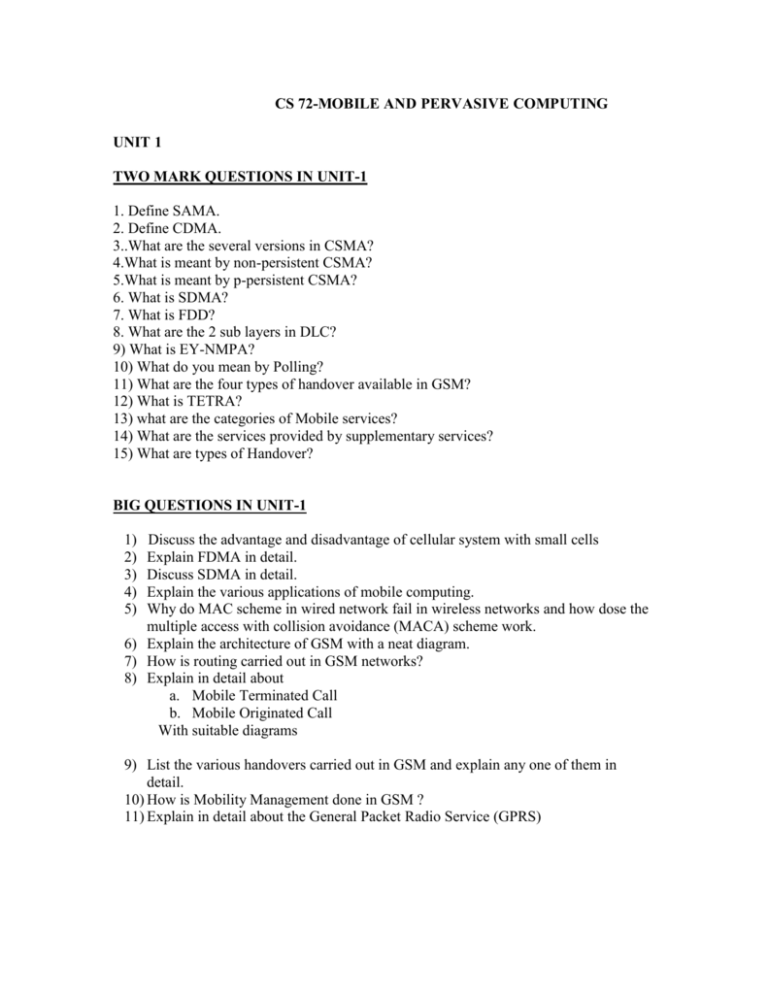
CS 72-MOBILE AND PERVASIVE COMPUTING UNIT 1 TWO MARK QUESTIONS IN UNIT-1 1. Define SAMA. 2. Define CDMA. 3..What are the several versions in CSMA? 4.What is meant by non-persistent CSMA? 5.What is meant by p-persistent CSMA? 6. What is SDMA? 7. What is FDD? 8. What are the 2 sub layers in DLC? 9) What is EY-NMPA? 10) What do you mean by Polling? 11) What are the four types of handover available in GSM? 12) What is TETRA? 13) what are the categories of Mobile services? 14) What are the services provided by supplementary services? 15) What are types of Handover? BIG QUESTIONS IN UNIT-1 1) 2) 3) 4) 5) Discuss the advantage and disadvantage of cellular system with small cells Explain FDMA in detail. Discuss SDMA in detail. Explain the various applications of mobile computing. Why do MAC scheme in wired network fail in wireless networks and how dose the multiple access with collision avoidance (MACA) scheme work. 6) Explain the architecture of GSM with a neat diagram. 7) How is routing carried out in GSM networks? 8) Explain in detail about a. Mobile Terminated Call b. Mobile Originated Call With suitable diagrams 9) List the various handovers carried out in GSM and explain any one of them in detail. 10) How is Mobility Management done in GSM ? 11) Explain in detail about the General Packet Radio Service (GPRS) UNIT II TWO MARK QUESTIONS IN UNIT-II 1. Expand and explain WLAN? 2. What are the advantages of WLAN? 3. What is an ad-hoc network? 4. List the low power states of Bluetooth? 5. Expand and explain HIPERLAN? 6. What is IEEE 802.11 standard? 7. How is the physical layer subdivided in IEE 802.11 standard? 8. What is PLCP? 9. What is PMD? 10. What are the functions of MAC management? 11. Define SIFS. 12. Define PIFS. 13. Define DIFS. 14. What are the 2 types of scanning in roaming? 15. List the phases in EY-NPMA? 16. What are the different types of channels used in hiperlan2? 17. Differentiate p scanners and p supporters. 18. What is Passive Scanning? 19. What is Active Scanning? 20. List the merits and demerits of Bluetooth. BIG QUESTIONS IN UNIT-II 1. 2. 3. 4. 5. 6. 7. Explain in detail the three phases of EY-NMPA in Hiperlan. List the various information bases in Hiperlan and explain the same. Discuss the architecture of Bluetooth in detail. Explain the architecture of WIFI in detail. Explain the architecture of WIMAX in detail. Describe Hiperlan architecture with suitable diagrams. List out the various MAC management services and explain any 2 of them in detail. 8. Draw the MAC frame format and explain its various fields in detail. 9. Explain DFWMAC-DCF using CSMA /CA. 10. Explain DFWMAC-DCF with RTS/CTS extension. 11. Explain DFWMAC-DCF with polling. UNIT III TWO MARK QUESTIONS IN UNIT-3 1. What does the term mobile IP mean? 2. What are the 2 addresses of a mobile node? 3. What are the entities of Mobile IP? 4. What is Home Agent? 5. Define Triangular Routing. 6. What are the types of COA? 7. What are Advantages and Disadvantages of Infrared? 8. Define tunneling. 9. What is encapsulation? 10. What is decapsulation? 11. What are the types of encapsulation? 12. What are the steps in performing optimization? 13. Expand and explain DHCP. 14. What is DSDV? 15. How is routing carried out using DSR? 16. List the benefits of DSR. 17. Define ‘Reverse Tunneling’. 18. What is GRE? 19. What is mobility extension? 20. What is a foreign agent? BIG QUESTIONS IN UNIT-3 1. Explain how a. End to End packet delivery is done in mobile IP b. Agent advertisement is done in mobile IP 2. Explain how registration of a Mobile Node is carried out with appropriate request and reply packet formats. 3. Explain in detail about the IP in IP and minimal encapsulations. 4. Explain in detail about GRE encapsulation with the appropriate packet format. 5. Describe the process of optimization in Mobile IP with a suitable timeline diagram. 6. Explain in detail about DHCP. 7. Discuss DSDV routing in detail. 8. Discuss DSR routing in detail. 9. Why is conventional routing in wired networks not suitable for wireless networks? Substantiate your answers with suitable examples. 10. How is multicast routing carried out in ad-hoc networks? UNIT 1V TWO MARK QUESTIONS IN UNIT-1V 1. What do you mean by the term ‘Snooping TCP’?. What is its demerit? 2. What is ‘Indirect TCP’? 3. What is Mobile TCP? List its merits. 4. List out the advantages of I-TCP. 5. List out disadvantages of I-TCP. 6. What is WAP? 7. Define WAE. 8. What is WML? 9. Write short notes on WAP forum. 10. Distinguish between Traditional TCP and wireless TCP? 11. What is WTP? What are its classes? 12. List out the network elements of WAP. 13. What are the configuration parameters to adapt TCP to wireless environments? 14. State the requirements of WAP. 15. Name the layers of WAP. 16. What is WTP? What are its classes? 17. What is WSP? 18. Name some features of WSP adapted to web browsing. 19. What is WML? 20. What are the features of WML? 21. What are the advantages of WML Script over WML? 22. Name the libraries specified by WML Script. BIG QUESTIONS IN UNIT-1V 1. Explain in detail about WAP architecture. 2. Write notes on WDP and WTLS. 3. Write notes on wireless sessions protocol 4. Discuss about WAE. 5. Discuss about WTP and its classes. 6. Explain the following: Snooping TCP and Indirect TCP. 7. Explain about WML and WML script with the help of an example. 8. Explain classical TCP improvements and snooping TCP. 9. Discuss about the WWW programming model in detail. 10. Explain about the architecture of WTA. UNIT V TWO MARK QUESTIONS IN UNIT-V 1. What is Pervasive Computing? 2. What are the basic aspects of a Pervasive Computing environment? 3. What are the major choices available for battery design in Pervasive Computing Devices? 4. Why does Power consumption plays a vital role in pervasive computing? 5. What are the different display device technologies available? 6. What are the 2 basic elements needed with respect to connectivity in Pervasive Computing? 7. Compare and contrast the 1G 2G and 3G technologies. 8. What is meant by 2.5G technology? 9. List the different types of memories available for Pervasive Computing Devices. 10. Describe EPOX Operating System. 11. What is PALM OS? 12. Explain briefly about BE OS. 13. Compare and contrast Windows and Linux OSes. 14. What does the term ‘FITALY’ mean? 15. Describe briefly about the tegic T9 dictionary mode. 16. What is ‘Ocatve’?. 17. What is meant by Bio-Metrics? 18. What is a ‘Haptic Interface’?. 19. What are three steps involved in the process of Synchronization? 20. Why is device management important in Pervasive Computing? BIG QUESTIONS IN UNIT-V 1. Discuss in detail about any two Pervasive Applications of your choice in detail. 2. Explain about the various hardware components involved in Pervasive Computing Devices. 3. Write brief notes on the following. a. Speech Recognition b. Handwriting recognition c. Haptic Interfaces d. QWERTY and FITALY keyboards 4. Explain in detail about Bio-Metrics. List out its merits and demerits. 5. How is synchronization carried out in a Pervasive Environment? Write brief notes on the syncML tool. 6. What are the various issues related to device management and how are they dealt with? 7. Explain how a Pervasive Web Application can be secured using an ‘Authentication Proxy’. 8. How security is achieved in MVC and JSP based applications? 9. Discuss in detail about the access form PCs. 10. How is access carried out in case of a PDA? 11. Explain in detail about access via WAP.


